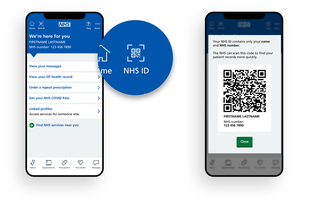Show My Patient ID prototype
How might we allow patients to more efficiently, accurately, and privately provide their personal details to staff when arriving at a care setting? We found that adding a QR code to the NHS App could free up £95m of staff time per year.
Prototype information
Carried out over three phases between February 2021 - March 2023
In collaboration with:
Wharfedale Hospital
What was the problem?
When patients or service users arrive at a care setting such as a hospital, there is often a need to collect their demographic information to create or locate their digital records. Currently, this is mostly done by the patient speaking and the staff member typing.
However…
- Patients have to give personally identifiable information, out loud, in a public environment.
- This process is often time-consuming, causing queues to build up.
- Some patients find verbal communication difficult, for example if English is not their first language, or because of a medical condition or disability affecting hearing, speech, or cognition.
- Mis-typing contact details can lead to duplicate records being created, confidential information being sent to the wrong person or not reaching the patient, resulting in them missing important test results or treatments.
- Patient demographic records may not be correct, and even if amended on reception, updated patient details often do not flow to other settings even between two departments in the same hospital.
- On very rare occasions, misidentifying patients can cause clinical harm.
What could be the benefit of improving this?
- Saving time - our initial modelling showed that if we could halve the time taken to create a record in A&E, outpatients and new GP registrations (and avoid wasted time 'hunting' for patient data) we could save time to the value of £95 million per year.
- Make the process of arriving at an appointment more accessible and inclusive.
- Preserve patients’ privacy.
- Improve the quality of data held by the NHS, by reducing the risk of errors being introduced into the patient’s record, and ensuring we have the most current, accurate demographic information at the point of access to services.
- Improve patients’ experience.
- Reduce wastage, for example letters sent to the wrong place, or staff time spent tracking down correct patient contact details or manually deduplicating records.
Our hypothesis
We believe that allowing patients to identify themselves using a machine-readable format will allow the staff to match them with their electronic records more efficiently, accurately and privately.
What did we do?
- User research with clinicians, admin staff and a diverse sample of patients including seldom-heard groups.
- Explored technical approaches including NFC and QR codes.
- We created a prototype version of the NHS App that generates a 2D barcode containing their contact data which the patient chooses to show to NHS staff.
- We created a simulated Patient Administration System (PAS) to receive data via a scanner when a patient arrives.
- We tested it on-site in a hospital outpatient department.
- We carried out further research with patients and staff to understand the language and labelling which was most effective at communicating this feature.
- We engaged with internal NHS stakeholders and PAS/Electronic Patient Record (EPR) system suppliers.
- We developed an AI-powered scanner which simulates a QR code scan by reading the NHS App homepage using machine-vision, to allow testing in a real setting

What were the outcomes?
- Reduction in average check-in time from 106 seconds to 35 seconds during testing.
- Data which showed that the most time-consuming arrivals in an out-patient setting involved missing or incorrect contact details.
- User research insights from staff and patients.
- Recommendation report identifying route to roll out.
- Open sourced the code of our proof of concept.
- Engaged with hospitals and Patient Admission System (PAS) vendors
What did we learn?
- Patients and staff were keen to see this implemented
- There is an opportunity to save time for patients and staff and improve data quality
- There is an opportunity to improve inclusivity and accessibility by providing an alternative to verbal communication
- While not every patient has access to smartphones and NHS App, all patients would benefit from shorter queues at reception desks
- Most benefit could be gained in unplanned care settings (such as A&E) where staff don’t know the identity in advance of patients walking through the door, or settings where privacy is especially important, such as sexual health clinics or pharmacies
- Patients were generally comfortable with calling this feature “Patient ID” or “NHS ID”
- Implementation will require collaboration between NHS App and PAS suppliers, and there is a “chicken and egg” problem about prioritising on both sides’ road maps
More information
If you would like to talk to us about this project, you can contact us at england.innovation.lab@nhs.net
About the NHS Innovation Lab
The NHS Innovation Lab was established to develop and test novel solutions to challenges facing the health and social care systems. Using innovative thinking and user-centred design processes, between 2020 and 2023 it explored dozens of problems across many different areas which, if solved, had the potential for substantial impact for patients, staff and organisations.